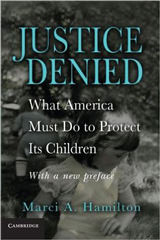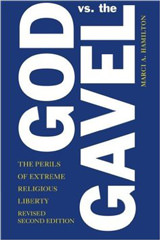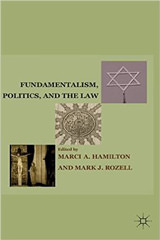The media and law-professor listservs are rife with debates about what the same-sex marriage opinions actually said this week. We know the bottom line: at the end of the Supreme Court’s 2012 Term, same-sex couples won.
In United States v. Windsor, the Court invalidated Sec. 3 of the Defense of Marriage Age (DOMA), which means that same-sex couples now will receive the federal benefits (and obligations) that any other legally-married couple obtains. In Hollingsworth v. Perry—because of a legal technicality, really—the District Court’s order invalidating Prop 8 stands, which means that California couples will be able to wed soon. (For details on the Windsor decision, I recommend my colleague Joanna Grossman’s column.)
The Perry decision on Article III standing will be the stuff of Federal Courts courses and law review debates for years to come.
While there is much well-deserved celebration, it is critical that everyone understand that same-sex couples still did not walk away with a constitutional right to be married in any state. That is because the one substantive decision, Windsor, rests on a joint platform of federalism and constitutional due process principles. The decision’s language, to be sure, will make it more difficult to discriminate against same-sex couples seeking marriage, but the Constitution’s structural requirement that states hold primary authority over the definition of marriage, on which the decision heavily relies, leaves the decision of who can get married solidly in the hands of the states. Congress is, thus, not the body that can provide what same-sex couples are seeking, and same-sex couples will need to make their case in many states in the future.
Windsor as a Decision Partly Based on Structural Constitutional Principles
It is typical for the media to insist on reducing any Supreme Court decision to such basics that, for those who fully understand the decision, the public discussion can seem almost beside the point. It is also common for law professors to engage in what I call “cubbyhole” constitutional thinking, in which they insist that a Supreme Court decision must be placed in only one constitutional category at a time. Accordingly,
there has been debate over the last several days over whether Windsor is a federalism (or, as it is commonly called “states rights”) decision, or instead a due process decision.
It is my view that such insistence on an either-or reading of constitutional doctrine drives us down false and misleading paths, and that the result in Windsor was just as much about federalism as it was about due process for same-sex couples. In fact, the two issues are intertwined and inseparable.
What many analyzing Windsor have failed to fully grasp is that the Supreme Court—ever since the start of the Rehnquist Court—has insisted on fealty to the Constitution’s structure, as well as to its words. The Court has repeatedly reasoned from the proposition that the “structure” of the Constitution is a critical and necessary element to any constitutional analysis, including rights analysis. The Court has paid explicit homage to the Constitution’s design and employed its structure to guide and explain the relative roles of the federal branches, and those of the federal government and the states. Thus, when the Court reached its landmark decision in Employment Div. v. Smith, in which it surveyed its free exercise of religion jurisprudence and provided a big picture analysis, the Court explained not only the parameters of the right, but also the way legislatures operate when approached to accommodate religious practices. Similarly, in Boerne v. Flores, the Court invalidated the Religious Freedom Restoration Act, not solely on the basis of what Sec. 5 of the Fourteenth Amendment provides, but also on the structural relationship between the Court and Congress.
Whatever you call this approach, the Court has frequently treated rights questions as necessarily linked to structural questions, which I view as a wholesome respect for the design of the Constitution as a whole, and not just its isolated words.
In Windsor, the vital structural element is the relative role of the states and federal government on issues of marriage. The Court stated as follows:
“In order to assess the validity of [DOMA’s rejection of same-sex marriage as marriage for federal purposes] it is necessary to discuss the extent of the state power and authority over marriage as a matter of history and tradition. State laws defining and regulating marriage, of course, must respect the constitutional rights of persons, see, e.g., Loving v. Virginia, 388 U. S. 1 (1967); but, subject to those guarantees, “regulation of domestic relations” is “an area that has long been regarded as a virtually exclusive province of the States.” Sosna v. Iowa, 419 U. S. 393, 404 (1975).”
Consistent with its previous federalism decisions, the Court first addressed which sovereign(s) properly controls the issue at hand, and only then addressed the rights question. As the Court noted in United States v. Lopez, and repeated in Windsor, there are arenas that inherently belong to the states. One of them is without question domestic relations. (Others include land use, education, and much of criminal law.)
The Court explained this point quite clearly:
“The recognition of civil marriages is central to state domestic relations law applicable to its residents and citizens. See Williams v. North Carolina, 317 U. S. 287, 298 (1942) (“Each state as a sovereign has a rightful and legitimate concern in the marital status of persons domiciled within its borders”). The definition of marriage is the foundation of the State’s broader authority to regulate the subject of domestic relations with respect to the“[p]rotection of offspring, property interests, and the enforcement of marital responsibilities.” Ibid. “[T]he states, at the time of the adoption of the Constitution, possessed full power over the subject of marriage and divorce . . . [and] the Constitution delegated no authority to the Government of the United States on the subject of marriage and divorce.” Haddock v. Haddock, 201 U. S. 562, 575 (1906); see also In re Burrus, 136 U. S. 586, 593–594 (1890) (“The whole subject of the domestic relations of husband and wife, parent and child, belongs to the laws of the States and not to the laws of the United States”). Consistent with this allocation of authority, the Federal Government, through our history, has deferred to state law policy decisions with respect to domestic relations.”
Therefore, Congress’s enactment of DOMA, which singles out a definition of marriage that had been crafted by some states, raised a red flag. It is not simply that the victims of the distinction—same-sex couples who are deprived of federal benefits—were hurt by the distinction, but also that the federal government had stepped out of its ordinary role to disable them, and had failed to respect a state’s determination of who is married and who is not. This structural element of the Constitution adds force to the rights-based criticism of Congress in Windsor.
Because of this structure, the federal courts have stayed out of the domestic dispute fray:
“[T]he federal courts, as a general rule, do not adjudicate issues of marital status even when there might otherwise be a basis for federal jurisdiction. See Ankenbrandt v. Richards, 504 U. S. 689, 703 (1992). Federal courts will not hear divorce and custody cases even if they arise in diversity because of “the virtually exclusive primacy . . . of the States in the regulation of domestic relations.” Id., at 714 (Blackmun, J., concurring in judgment).” The majority continues by pointing out that this division of labor has been with us since the start of the country.
The Court, less successfully in my view, asserts that the decision is not about federalism per se: “[I]t is unnecessary to decide whether this federal intrusion on state power is a violation of the Constitution because it disrupts the federal balance. The State’s power in defining the marital relation is of central relevance in this case quite apart from principles of federalism.” Given the significant portion of the opinion devoted to federalism themes, this seems a distinction without a difference, thought to be fair to the majority, Kennedy may just be pointing out that federalism cannot by itself solve the constitutional puzzle in this case.
Roberts’s dissent is interesting, because he takes pains to assign the federalism label to the majority, when he asserts that “it is undeniable that [the majority’s] judgment is based on federalism.” He also emphasizes that the decision did not hold that the states must recognize gay marriage. Quite to the contrary, he says, “The Court does not have before it, and the logic of its opinion does not decide, the distinct question whether the States, in the exercise of their ‘historic and essential authority to define the marital relation,’ may continue to utilize the traditional definition of marriage.”
He is correct; the majority only decided that the states have primary authority over marriage and that the federal government’s enactment of its law singling out same-sex marriage for negative treatment violated the Due Process Clause. The reins over the definition of marriage remain in the states’ hands.
The Constitutional Right at Issue in Windsor
The majority, after establishing the constitutional structural foundation, goes on to conclude that the federal government, with Sec. 3 of DOMA, violated same sex couples’ Fifth Amendment due process rights. The decision reads equal protection principles into the Fifth Amendment, which is nothing new. (The Fourteenth Amendment’s Equal Protection Clause only applies to the states, while the Fifth Amendment is the source of such rights against the federal government.)
Neither is the notion that singling out homosexuals for negative treatment violates equality principles. Kennedy himself wrote the opinion in Romer v. Evans, which held that bare animus was the only justification behind the Colorado initiative in that case, which forbade local governments from instituting anti-discrimination laws based on sexual orientation. The reasoning of Romer, without question, flavors Windsor, as the Court’s analysis of DOMA includes a finding that Congress had no other interest other than disabling same-sex marriages. The foray into an arena where Congress does not typically belong, combined with singling out same-sex couples without any legitimate justification, led the majority to conclude that Sec. 3 of DOMA must fall.
Of course, the dissenters—particularly Justice Scalia and Alito—affected an offended posture that they were told that there was no legitimate reason for DOMA other than disabling same-sex couples. According to those two Justices, the members who advocated for DOMA were good people who deserve to be treated with respect, not bigots.
It reminds me of the time when I was upbraided for using the term “religious lobbyist,” as though they don’t exist. Sometimes the truth has to be said, even when religious believers want you to treat it as taboo. It may be an uncomfortable and unpleasant reality for those on that side, but their opposition to gay marriage is rapidly becoming the modern equivalent of the opposition to bi-racial unions before Loving v. Virginia. Believe what you want, but don’t expect those who view this as a human rights and civil rights issue to treat discrimination against same-sex couples as a morally neutral position.
Moreover, the burden placed on a believer opposed to gay marriage is dramatically less than the burden placed on the same-sex couple who cannot marry.
In reality, the type of marriage that is favored by the opponents of gay marriage—heterosexual marriage—is not being threatened, as no one is contending that heterosexual marriage must end. Nor is anyone forcing the opponents to attend a gay wedding, to have gay couples as friends, or to agree with their decision to get married. Their objection, at its very core, is that they want the government to perpetuate their religious worldview and force on gay couples that world view’s formula for marriage. This is similar to what is being asserted in the arguments by for-profit business owners against health insurance coverage for reproductive health care—it is not that their beliefs are being burdened, but rather that they want to force non-believers to follow their practices. These are dangerous steps toward theocracy, which have no place in the American system, and certainly are not legitimate reasons to support DOMA.
Thus, the Windsor decision rests on an amalgam of constitutional principles. If the federal government had plenary or primary authority over the definition of marriage, then perhaps DOMA would have been constitutional, but it also would have been unnecessary, because Congress could have controlled the issue! Congress has known from the beginning that its members don’t have primary authority over marriage, as evidenced by the fact they enacted DOMA, and not a law that mandated marriage between a man and a woman. The conservatives, moreover, floated constitutional amendments to require marriages be heterosexual, which also are a concession that it would take a constitutional amendment to give the federal government that authority and power over marriage. In the end, the structure of the Constitution, the settled power over marriage in the states, and the singling out of same-sex couples combined to take down DOMA.
The upshot is that same-sex couples and their friends and families will have 14 jurisdictions, including the District of Columbia, where they will be able to marry and where they also will be able to receive the identical federal benefits received by heterosexual couples. But there are 37 states left to persuade, and in those states, federal benefits for married couples can be limited to heterosexual couples. The former truly is great news, even if the latter is not easy news.










And yet in Shelby County v. Holder, this same Court seems to have rejected the structure argument altogether. Opinion weeks like this makes wonder about the bi-polar nature of SCOTUS. What happened to deferring to Congressional findings of fact? It is not as though the VRA had not been recently re-approved.
An excellent legal analysis by Prof. Hamilton. Well worth the time
to read and analyze. However, Prof. Hamilton digresses into a bit of
social commentary which appears to be on slightly shakier grounds. For
instance, Prof. Hamilton asserts that “no one is contending that
heterosexual marriage must end.” To the contrary, gay activist Masha
Gessen has candidly and expressly stated, to great applause, that this
is the true goal behind the “gay marriage” movement. I don’t have any
idea if Ms. Gessen’s position is actually widely accepted, but the fact
that there is such thinking on the part of some activists must be
noted. I also question the rather simplistic manner in which Prof.
Hamilton frames the issues regarding insurance coverage for
reproductive health care.
Anyway, thank you for a very worthwhile article.
The term “no one” like “never” is usually used to mean “generally speaking” and the fact some activist makes a statement of this sort doesn’t change that. When someone says “no one does that,” you usually can find someone who does, but the statement is still mostly true.